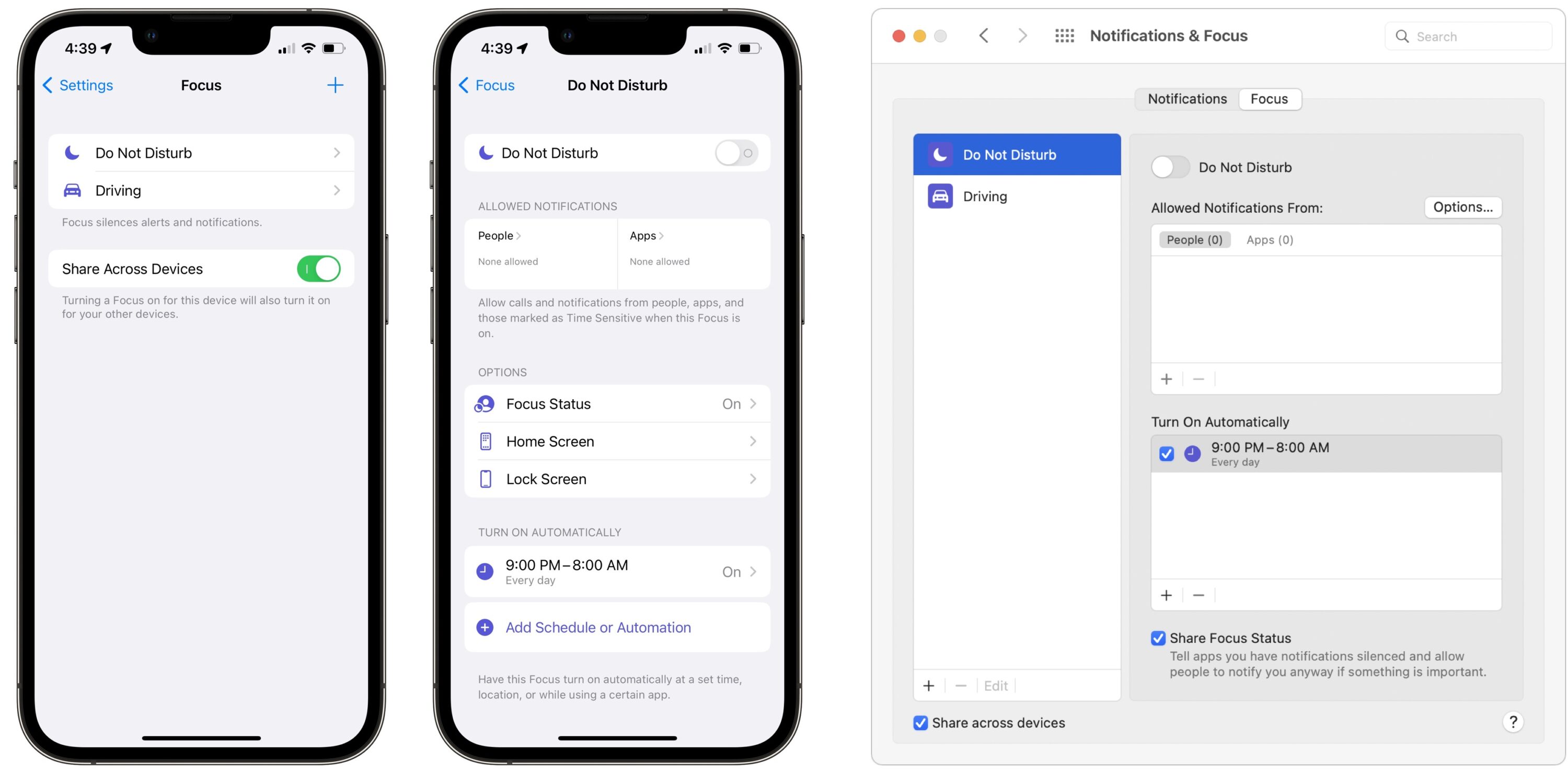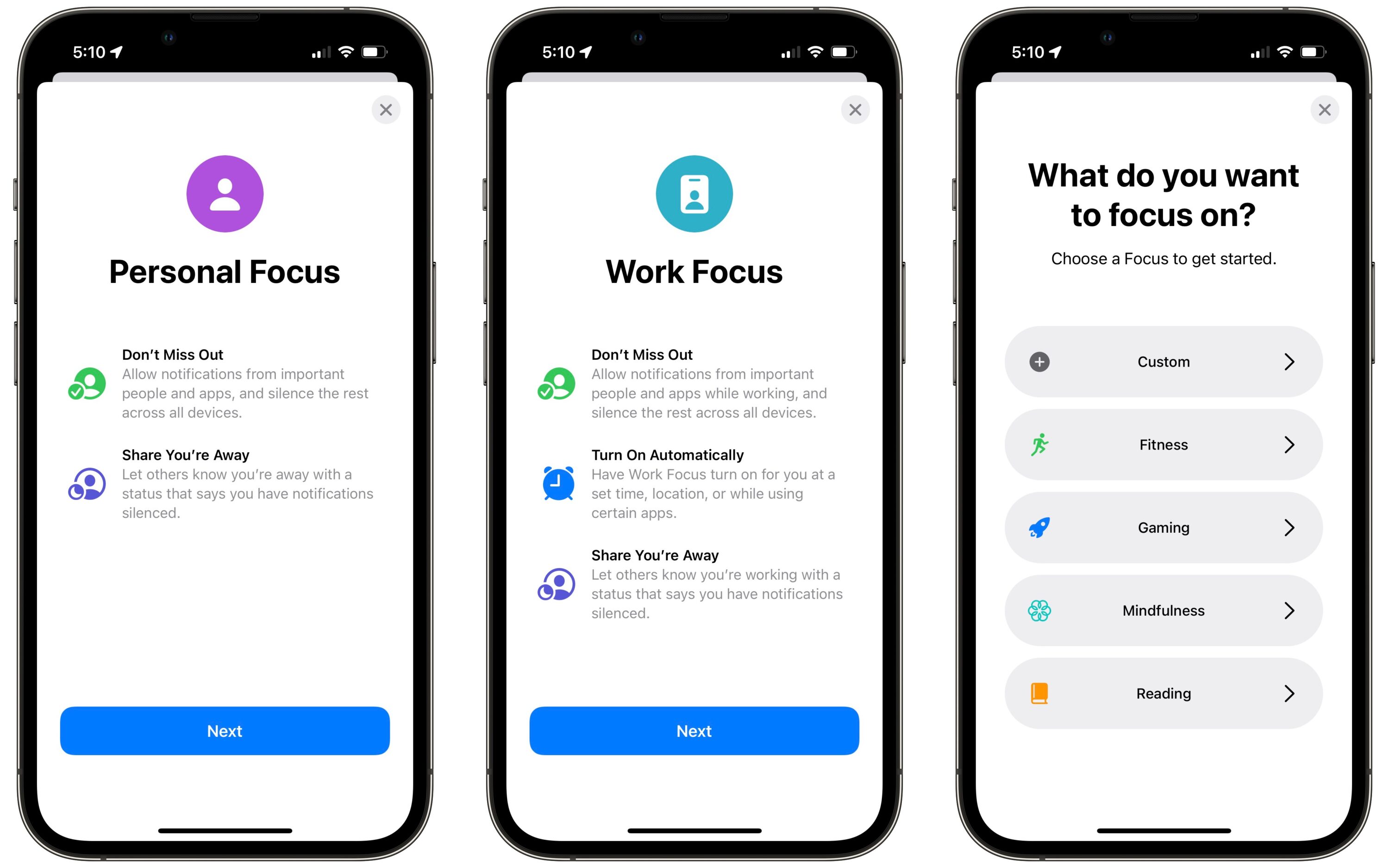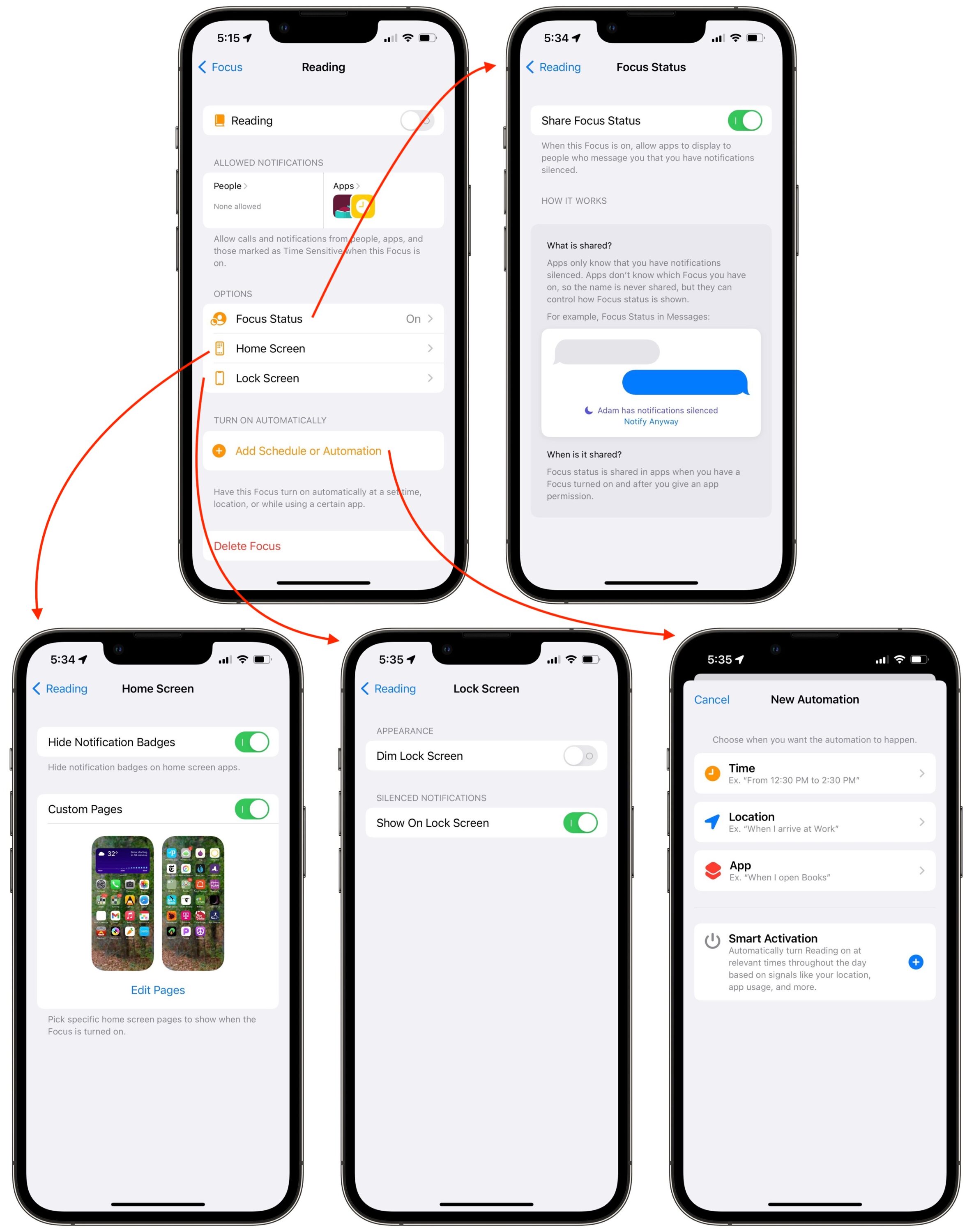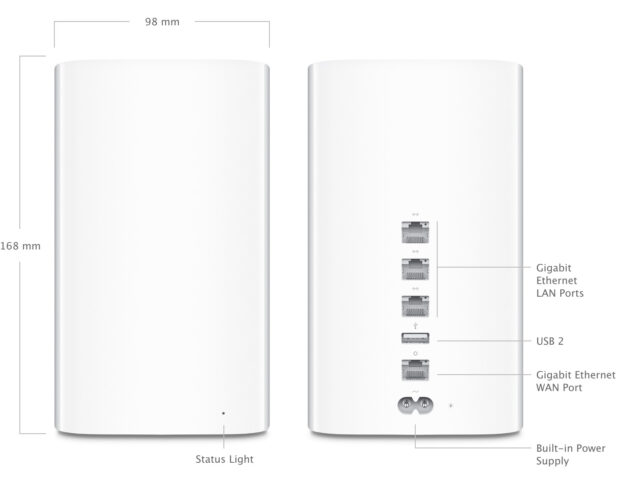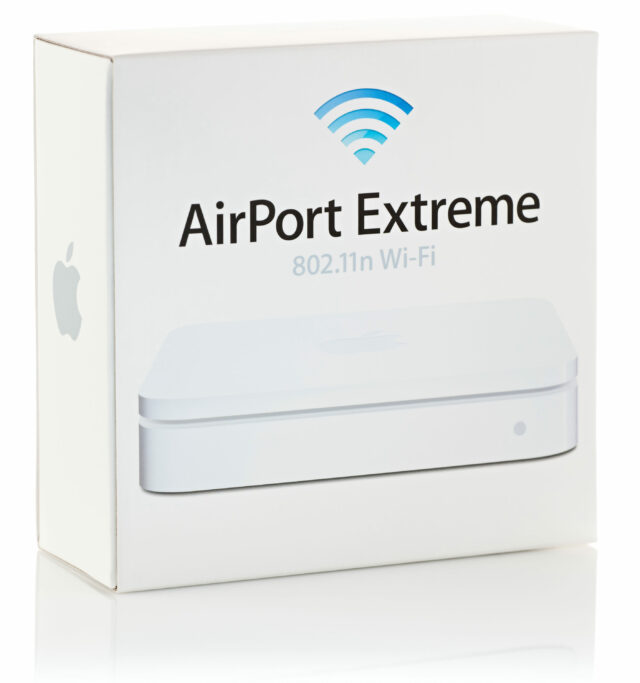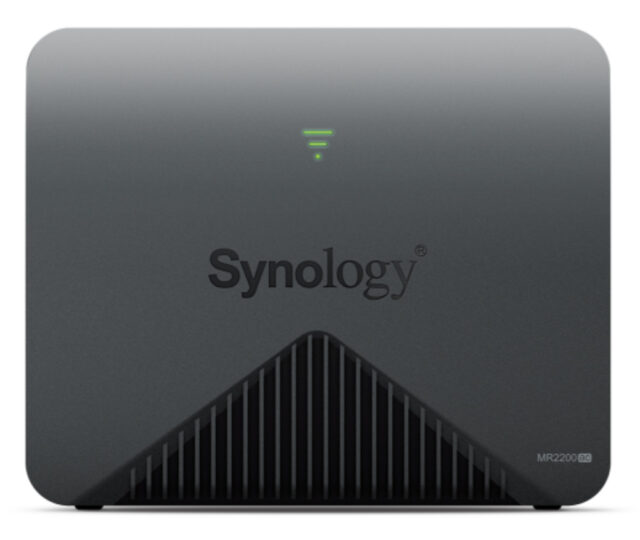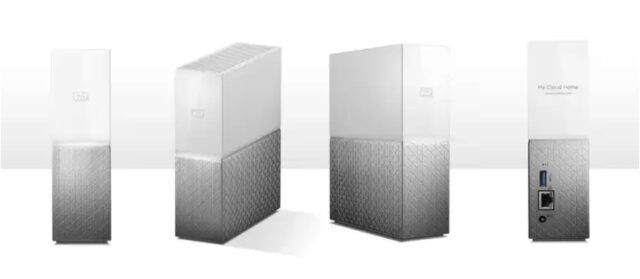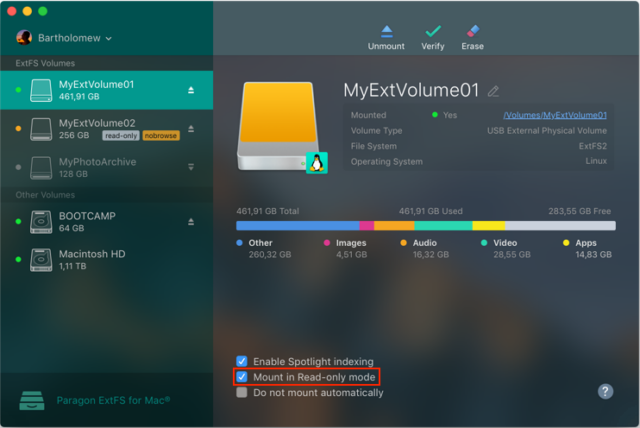#1595: Replacing the Time Capsule, AT&T and Verizon 5G coverage expands, is iOS 15’s Focus overkill?
If you rely on AT&T or Verizon for cellular data, you may be seeing improved 5G performance as the carriers take advantage of the newly available C-band radio spectrum—Julio Ojeda-Zapata shares the details. Apple discontinued the Time Capsule in 2018, and while it was never the ultimate backup solution, it provided a simple and well-supported option to many Mac users. For those seeking a modern system for network Time Machine backups, consultant Ivan Drucker takes us on an odyssey of exploration through all the available options. Along with a Mac user group and Mac blog recommendation in his LittleBITS column, Adam Engst reviews the new Focus feature in Apple’s latest operating systems, explaining why he thinks it’s overkill for most users and might be a reason you miss important notifications. The only notable Mac app release this week is Pixelmator Pro 2.3.5.
LittleBITS: iCloud Delivery Issues, Naples MUG, Howard Oakley
This week’s collection of updates and recommendations that don’t warrant a full article includes a status update on TidBITS delivery problems experienced by at least some iCloud users, a free NMUG membership through the end of the month, and a blog that all technically involved Mac users should be reading.
Last Week’s iCloud Delivery Problem Theoretically Resolved
Six months ago, we had a problem with iCloud rejecting TidBITS issues (see “Resetting Recent iCloud Bouncing Subscribers,” 30 August 2021), and with that fresh in her head, it took Lauri Reinhardt only a few days to realize that iCloud was up to its old tricks last week. She quickly replicated the problem by forwarding an issue to herself and sent me the SMTP headers to pass on to Apple. To the iCloud Mail team’s credit, they replied within a day, saying that they had resolved the issue. I reset all the affected icloud/me/mac.com addresses, and everything should be back to normal.
The upshot of this is that if you didn’t receive TidBITS last week at your iCloud account, that’s probably why. So if TidBITS #1595 doesn’t arrive normally (and you’re thus reading this on the Web), there may be something else going on. One possibility is that if you subscribe from a custom email address that forwards to iCloud, you may still be affected. Either way, contact Lauri for help.
Looking for a Mac User Group? Try the Naples MUG
When Tonya and I started TidBITS back in 1990, Mac user groups were powerhouse organizations. Seattle’s dBUG held meetings in a fancy downtown hotel (see “dBUGing,” 2 September 1991) thanks to sponsorship from companies like Microsoft (“Claris & Microsoft,” 23 September 1991) and Aldus (“Aldus Delivers,” 18 November 1991). The newsletter for the world’s largest Mac user group, Berkeley-based BMUG ran to hundreds of pages, thanks to articles by a veritable Who’s Who of Mac writers of the time, and it was also a major pre-Internet source of online Mac interaction (see “A Tale of Two Cities,” 29 March 1993).
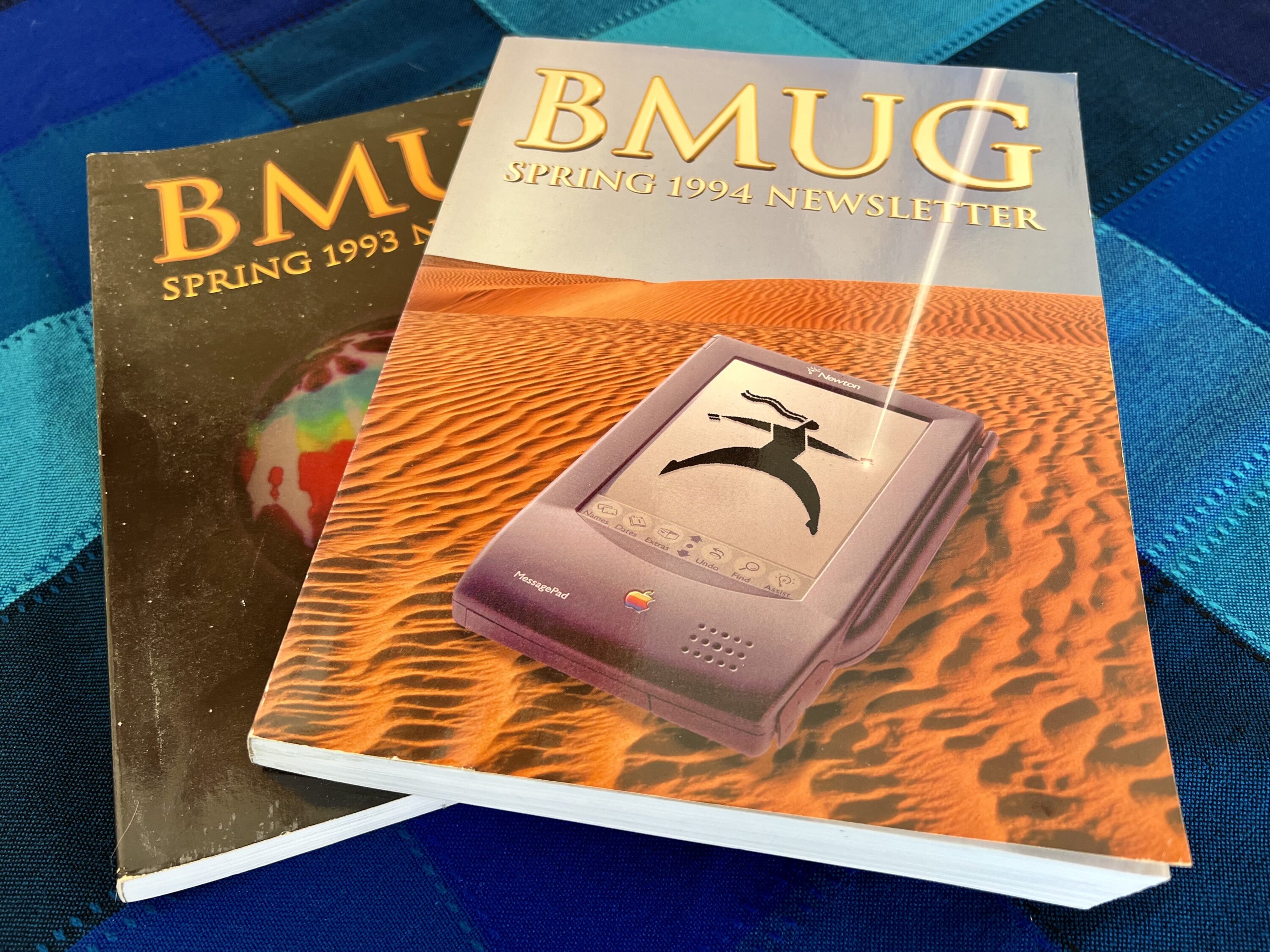
Things have changed, with the Internet reducing the desire for in-person meetings of like-minded Apple geeks. Many of the Mac user groups that have survived now have meetings that draw 10–30 people, mostly long-time regulars who have known each other for years and enjoy the social and intellectual interaction. There’s nothing wrong with that, just what I’ve observed over years of presenting at user group meetings.
At least one Mac user group has bucked the trend: the Naples MacFriends User Group, or NMUG. Based in Naples, Florida, and run by a dedicated group of largely retired volunteers, the nonprofit NMUG has leveraged the pandemic-driven move to online Zoom meetings to increase its membership to over 600 people from countries around the world. NMUG offers weekly 75-minute meetings on Apple-related topics, an active Groups.io message board, and classes with expert instructors, extensive notes, moderators, and post-class access to the video recordings. Many of us from TidBITS have presented at NMUG meetings over the years, and Josh Centers will be teaching an iPad class on 5 February 2022.
I mention NMUG here because anyone who joins through the end of January 2022 will receive a temporary free membership through the end of March 2022 that provides access to the weekly meetings and message board, plus allows registration for their classes. After March, the annual membership fee is $30. So if you’re pining for some of that old-time user group feel, give the NMUG free membership a try.
Recommending Howard Oakley’s Eclectic Light Company Blog
There are a lot of people doing good work in the Apple community, but the person I’m currently most impressed by is Howard Oakley. As I learned in a MacObserver interview, he attended Oxford and worked in the British Royal Navy as a doctor, becoming heavily involved with computers and programming along the way. In his retirement on the Isle of Wight, he does vastly more than most people of any age, writing detailed articles about Mac topics for his Eclectic Light Company blog, developing a large stable of freeware Mac utility apps, and writing heavily illustrated articles about fine art. (Yes, I realize that last one is off-topic, but I knew next to nothing about painting before subscribing to his posts, and now I can easily differentiate Bonnard from Seurat.) A recent post summarizes what he’s done over the past seven years.

I’ve mentioned Howard Oakley’s articles on occasion in TidBITS, but a recent pair of them inspired me to recommend him more generally. First, his “Solutions for macOS Monterey and Big Sur” provides a quick recap of things you can try to resolve a generic problem on the Mac in today’s world of signed system volumes and M1-based Macs. Second, “Did someone forget their password? Getting access to a locked Mac” lays out all the possible ways to recover from a lost password. So if you’re interested in articles about Mac topics that range from highly practical to rather technical, try adding the Eclectic Light Company to your reading list or follow him on Twitter. For me, because I prefer to have things appear in email, that means subscribing to his RSS feed via Blogtrottr.
AT&T and Verizon Debut Faster, More Widely Available 5G Service
5G support arrived for Apple users with the iPhone 12 models in late 2020. But, as I noted in “The iPhone Gets 5G, but What’s It Like in Real-World Use?” (19 November 2020), the high-speed wireless data service’s performance differed dramatically depending on where you lived and which wireless carrier you used. At the time, T-Mobile was the best 5G carrier option for most people in the United States because of its comprehensive three-tier service:
- Blazingly fast “high-band” service, technically known as millimeter wave, in pockets of some cities
- Slower but still zippy “middle-band” service blanketing hundreds of cities and towns
- “Low-band” service bathing much of the country (including rural areas) with data speeds roughly on par with traditional 4G LTE
Rival carriers AT&T and Verizon were at a major competitive disadvantage because they could provide only low-band 5G service nationwide, supplemented with high-band service in nooks and crannies of a few major cities. In the middle, neither AT&T nor Verizon could offer service because they lacked access to the necessary parts of the spectrum.
That changed on 19 January 2022 when AT&T and Verizon flipped the switch on C-band support, which refers to a swath of radio airwaves in the mid-band spectrum, similar to those used by T-Mobile. C-band support provides download speeds on the order of 1 gigabit per second under ideal conditions, though everyday performance is likely to be slower.
If the term “C-band” sounds familiar, it may be because you remember the days of large C-band satellite dishes that have now largely been replaced by smaller, fixed Ku-band dishes like those from Dish and DirecTV.
This new swath of spectrum has caused yet more controversy for 5G (see “Worried about 5G and Cancer? Here’s Why Wireless Networks Pose No Known Health Risk,” 6 December 2019). AT&T and Verizon have been tussling with the Federal Aviation Administration over the agency’s worries that the new wireless service might interfere with certain airplane radio altimeters that rely on similar spectrum. These concerns triggered delays in C-band deployment and more recently prompted the wireless carriers to hold off on activating some 5G towers near airports. James Fallows has another excellent summary of the situation.
As a practical matter for iPhone users, this quarrel has little effect on their ability to access C-band service. However, other factors might limit access for a while.
How to Tap into C-band
On the hardware front, the news is all good. If your device supports 5G, it can use AT&T and Verizon’s mid-band spectrum, along with their low-band and (if you are precisely in the right urban location) high-band services.
Supported devices include iPhone 12 and iPhone 13 models, along with 5G-capable iPads, such as current iPad Pro models, along with the sixth-generation iPad mini.
However, you need the right wireless plan. That’s not an issue for AT&T users because the mid-band service is automatically available with any plan that offers 5G access at no extra charge. However, if you’re a Verizon user, check out the 5G Play More, 5G Do More, and 5G Get More plans. Verizon’s entry-level 5G Start plan works with low-band but not mid- or high-band service.
You also need to reside in the right location to get C-band access. That’s where Verizon and AT&T diverge:
- For would-be AT&T users of the C-band spectrum, the news is not great. The carrier has announced availability in limited parts of eight US metro areas and regions: Austin, Chicago, Dallas/Fort Worth, Detroit, Houston, Jacksonville, Orlando, and South Florida.
- Verizon announced its C-band service is available to about 90 million people in 46 metropolitan areas as of 19 January 2022. It should be available to another 10 million people within the next month, about 90 percent of current 5G users.
Services known as mobile virtual network operators (MVNOs), which piggyback on the wireless networks of traditional providers and resell their data service in a rebranded form, will presumably work with C-band.
I’ve confirmed that Comcast’s Xfinity Mobile, a major MVNO that uses Verizon’s network, supports C-band. On the AT&T side, MVNOs will initially roll out C-band on iPhones but not Android phones, a spokesman told me. But MVNOs will still be hampered by AT&T’s limited C-band availability.
Hello, Home Broadband
C-band is relevant not only to phone and tablet users but also to those who want high-speed home broadband service and are looking for alternatives to the traditional providers such as Comcast Xfinity, Charter Communications, and Lumen Technologies (formerly CenturyLink).
As with its 5G phone service, T-Mobile has had an edge in the 5G-based home broadband space (see “T-Mobile Offers Unlimited 5G Home Broadband Service,” 14 April 2021) with its 5G Home Internet. The service is broadly available within the carrier’s mid-band footprint—though not every home address therein qualifies—and provides download speeds similar to what the carrier’s phone customers see.
AT&T doesn’t offer 5G home broadband but does provide a business-focused 5G broadband option.
Verizon’s 5G Home service competes with T-Mobile’s 5G Home Internet but was at a big disadvantage until recently. That’s because it relied on the carrier’s high-band service, which is available only in limited parts of about 80 US cities. Also problematic is the fact that high-band service functions better outdoors than indoors and is easily foiled by physical obstructions like light poles and tree leaves, making it the brunt of jokes.
Verizon is now expanding 5G Home support to C-band, which will dramatically expand its reach and potentially improve the service’s reliability since the mid-band signal should work indoors as well as outdoors. I’m hoping to try out 5G Home and may have more to say about it later.
The T-Mobile and Verizon 5G home broadband offerings work basically in the same way—they offer a modem-like gadget that plugs into power, taps into 5G airwaves, and connects the cellular Internet connection to high-speed Wi-Fi for laptops, phones, and other devices in a home.
Inching into the Future
Much has been made—at least by the industry—of 5G’s potential to remake society by enabling gee-whiz technologies such as autonomous vehicles, remotely controlled medical procedures, vast sensor networks, and much-talked-about metaverse (see “Understanding 5G, and Why It’s the Future (Not Present) for Mobile Communications,” 11 November 2020). It remains to be seen how much of this will come to pass, but the addition of C-band support by AT&T and Verizon goes a long way toward providing speedy, widely available 5G to more iPhone and iPad users.
Apple’s New Focus Feature May Be Overkill
Apple walks a fine line with the iPhone. On the one hand, it’s magic made manifest, giving you access to both the accumulated knowledge of the world and all the people you can juggle. On the other, the combination of Apple’s elegant hardware and the psychologically manipulative efforts of untold numbers of apps and services make the iPhone the ultimate distraction device, bordering on an addiction. For many, what happens on the iPhone is more compelling than nearly anything in real life. It’s the digital equivalent of crack cocaine rolled in Doritos coating, glammed up in the latest fashions. (The same applies, more or less, to all smartphones—I’m not actually singling out Apple here; I just don’t pay attention to Android smartphones.)
Of course, Apple is entirely aware of this tension. The company makes billions and billions from those who want their digital dopamine hits while proclaiming their fashion sense and deepening their tribal affiliation. But despite what detractors say, Apple isn’t a soulless moneymaking machine—if Facebook controlled the iPhone, we’d all be drooling zombies by now, incessantly pressing on the phone’s prominent Like button. Apple offers several solutions beyond the protections afforded by its flawed and controversial App Store approval process. First, the Screen Time technology lets us set limits to help corral our electronic urges. Second, Do Not Disturb gives us a chance to focus on the real world around us without fear of being sucked back in by the next notification. And Apple just introduced a way of gathering less-important notifications into scheduled groups—see “Reduce Distractions with Notification Summaries” (20 December 2021). We can argue about how effective these features are, but at least they’re present for those who have trouble being their best selves in the face of compelling digital distractions.
With iOS 15 and iPadOS 15, Apple revisited Do Not Disturb, a technology that had grown organically and somewhat awkwardly. When it was introduced in iOS 6 in 2012, Do Not Disturb focused on phone calls, but five years later, Apple added Do Not Disturb While Driving (see “iOS 11 to Bring Do Not Disturb While Driving,” 21 August 2017). The next year, iOS 12’s new Bedtime mode helped cut down on iPhone-induced wakeups (see “Inside iOS 12: Do Not Disturb Learns to Turn Itself Off,” 19 September 2018).
The product of 2021’s rethink is Focus, which subsumes all three of those features, suggests other scenarios, and lets users customize precisely which people and apps can break through your virtual cone of silence. Plus, Focus works on (and optionally syncs between) your iPhone, iPad, and Mac (running macOS 12 Monterey).
Focus on Functionality
In essence, Focus abstracts and extends the core functionality of Do Not Disturb, automatically blocking calls and notifications at certain times, at particular locations, or when you’re using certain apps. The idea is that you’ll be able to avoid interruptions during activities like working out, doing homework, eating dinner, or gaming. But not all interruptions—you can allow certain people and apps to break through. A Focus can also hide or show certain Home screen pages, prevent notifications from appearing on the Lock screen, and more.
To ensure that no one loses familiar capabilities, in Settings > Focus, Apple provides pre-built Focuses for Do Not Disturb, Driving, and Sleep to match the old Do Not Disturb options:
- Do Not Disturb: This catch-all Focus takes over from the old Do Not Disturb setting and may be all you need apart from the next item.
- Driving: This Focus replaces the old Do Not Disturb While Driving option. It doesn’t let you allow any app notifications through at all (keep your eyes on the road!). But you can write a custom auto-reply for those who text you while you’re driving.
- Sleep: If you use Apple’s sleep management features in the Health app, you’ll use this Focus to control which notifications can get through while you’re asleep—it replaces the previous Bedtime mode.
(Those three are on the iPhone, which seems to be the focus of Focus. The iPad and Mac lack Sleep and can’t activate Driving automatically. On the Mac, look for Focus settings in System Preferences > Notifications & Focus > Focus.)
If you can’t immediately think of how you would use Focus beyond these options, you’re not alone. As a result, Apple makes six suggestions: Personal and Work (in the main list) and Fitness, Gaming, Mindfulness, and Reading (when you add a new Focus). You can also create a custom Focus from scratch. Three of these suggestions are special: Fitness, Gaming, and Mindfulness can turn on automatically: when you’re engaged in a workout, when you connect a wireless controller, and when you’re in a Mindfulness session started from your Apple Watch, respectively.
When configuring a suggested focus or creating a new one from scratch, Focus runs you through several setup screens. One has you choose people whose notifications you want to come through regardless, and what to do about incoming phone calls. The other screen lets you pick which apps can notify you when the focus is active, with an additional option to allow notifications marked as Time Sensitive regardless. (Time Sensitive notifications include timed Reminders alerts, for instance, and are usually best left enabled—see “A Quick Primer on Time Sensitive Notifications,” 13 December 2021.)
Once your Focus is ready, you can configure various options, including:
- Focus Status: Enable this option to allow apps to alert those who message you that you have notifications silenced. As far as we know, this applies only to Messages; you can’t have a reply go through Slack or another messaging app.
- Home Screen: If your focus involves you using the Home screen a lot, you can have it hide notification badges that might lure you into another app or even hide entire Home screen pages that could be distracting. Beware, though, since having Home screen pages disappear unpredictably could be unsettling.
- Lock Screen: If you might be looking at your Lock screen while the focus is active, you can have it dim automatically and hide or show silenced notifications as appropriate. Again, be careful, since this feels like the sort of thing that could cause you confusion in the future.
- Schedule or Automation: Although you can turn on any focus from Control Center (tap the new Focus button), it may be easier to have it turn itself on automatically at certain times, in particular locations, or when certain apps are active. Automatic triggering is the ultimate confusion generator if you set something up, miss the banner or Lock screen icon, and later wonder why you missed important notifications.
In terms of functionality, the Focus feature provides all the flexibility one could want. But as I suggest above, with such power comes the opportunity to mess things up royally. When I was first testing Focus, I created a Fitness focus that turned on automatically when I was working out. I don’t use the Workout app on the Apple Watch, but I do use Strava, and on a 6-mile hike during which I was hoping to pass the time on phone calls with some relatives, I missed several return calls—I’d called and left messages—because Strava’s workout triggered the Fitness focus. Curses!
I’ll be blunt. The more I’ve lived with Focus and helped friends and relatives understand the implications of using it, the more the feature annoys me. My irritations include:
- Excessive encouragement: Apple’s suggestions encourage you to use Focus in situations where you might not have thought you had a problem on your own. Who doesn’t think, “Wow, wouldn’t it be nice to block notifications while I’m deep in some project?” But my strong suspicion is that most people will be incapable of designing a focus that’s simultaneously effective at blocking unwanted notifications and sufficiently porous for desired notifications. The question becomes: is it more problematic to process extra notifications or miss potentially important ones? I suspect most people will err on the side of processing extra alerts.
- Activation option overload: There are so many activation options—by time, by location, or by app—that it becomes nearly impossible to keep track of what might have triggered a particular focus. Making it even more unpredictable is the Smart Activation option, which turns the focus on automatically “at relevant times throughout the day based on signals like your location, app usage, and more.” Oh good, just what we need.
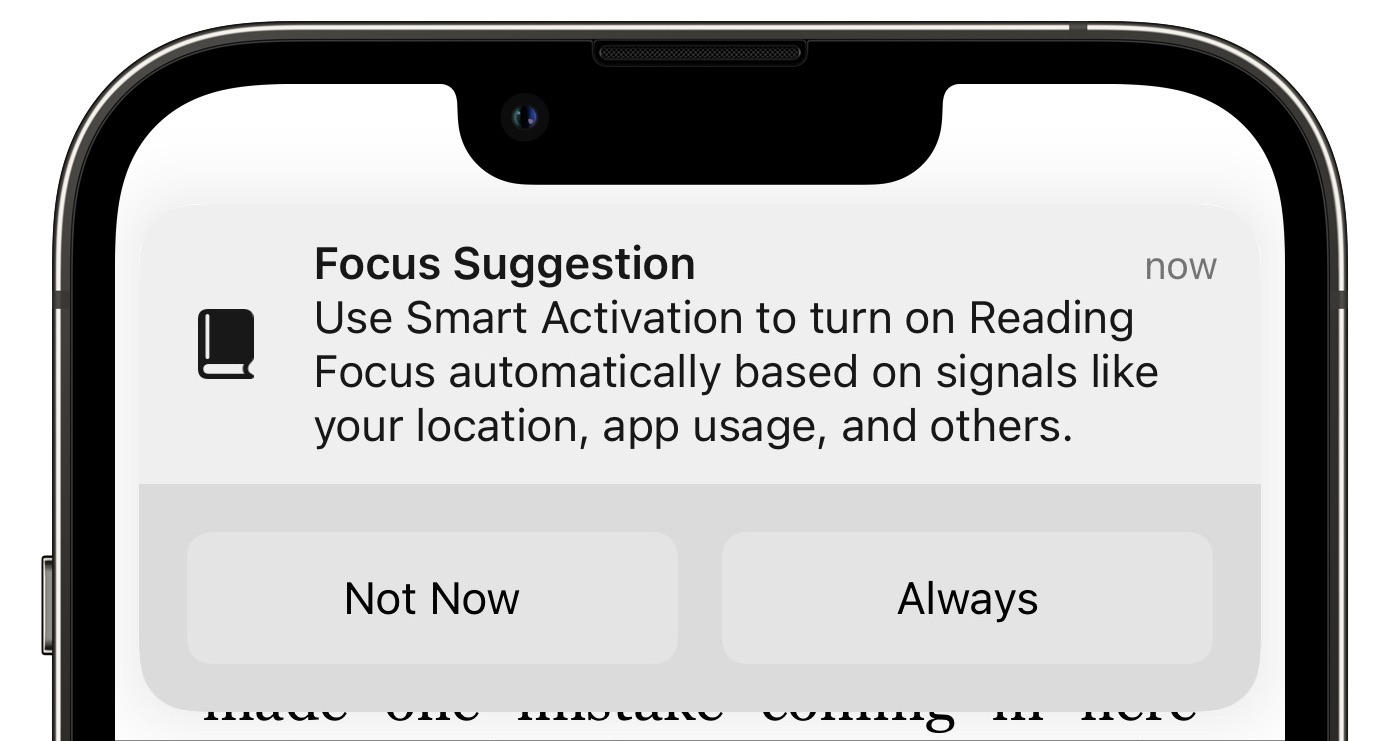
- Confusing state switch: At the top of each focus is a single switch that tracks the state of the focus and lets you toggle it manually. Maybe it’s just me, but whenever I edit a focus, I’m tripped up by the fact the switch is generally off. That’s “correct” if the focus is off, but it feels to me like it should be on to indicate that the focus will turn on at the right moment.
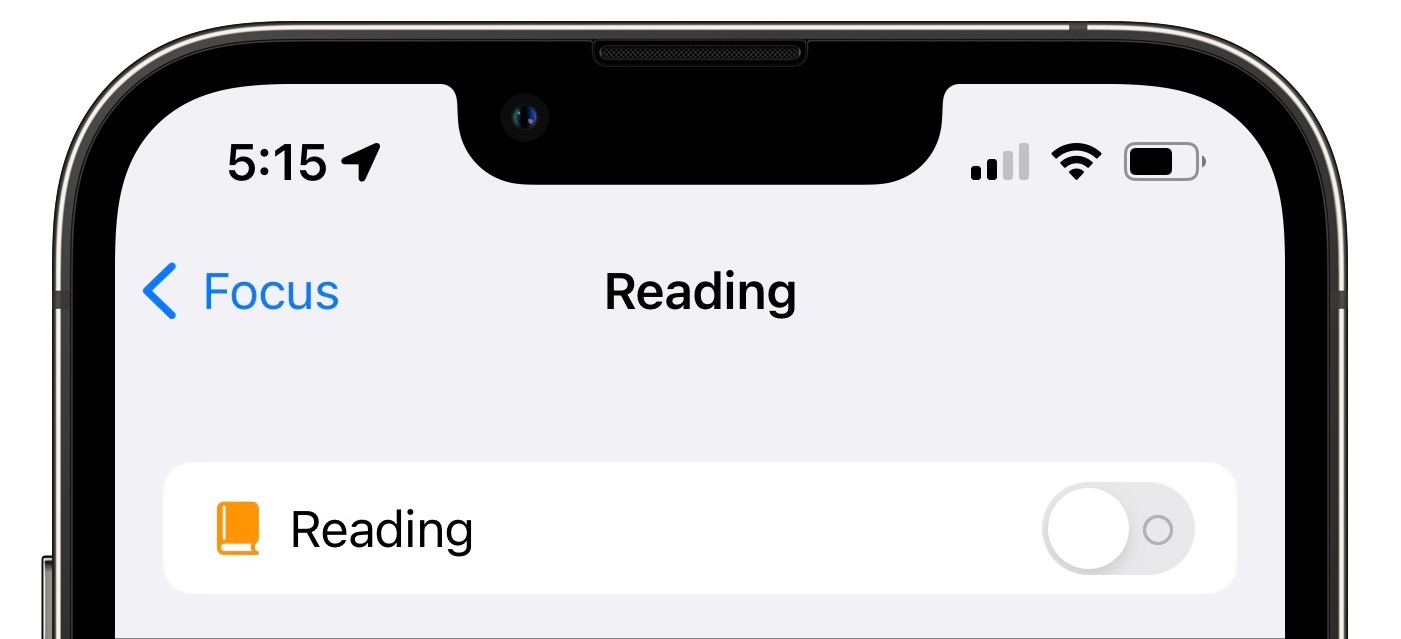
- Awkward cross-device sharing: On the main Focus screen, there’s an option, which I believe is the default, to Share Across Devices. When enabled, it makes Focus even more unpredictable, if such a thing could be possible. Open an app that triggers a focus on your iPhone, and suddenly your Mac is using the same focus. Who knows what effect that will have? Josh Centers noted that he set up a focus on his iPad so notifications wouldn’t appear when his son was practicing piano (see “Learn to Tickle the Ivories with Simply Piano,” 20 January 2022), but it disabled notifications on Josh’s iPhone and Mac at the same time, which obviously wasn’t desirable.
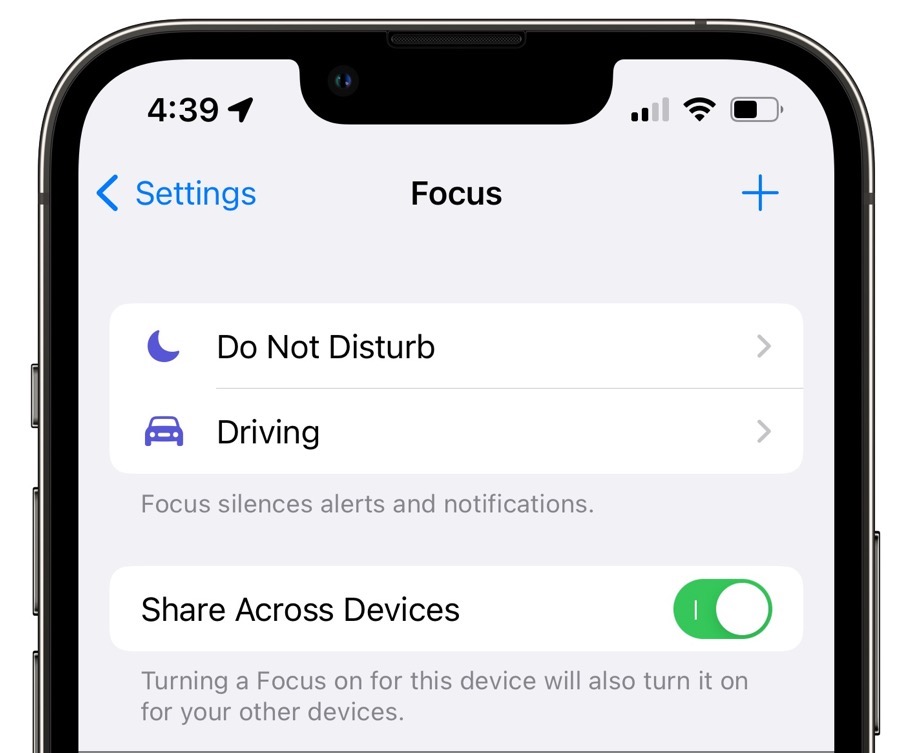
- Annoying banners: Whenever a focus turns on, my iPhone displays one of the new 6-second banners at the top of the screen—before Focus, I saw it primarily when my iPhone unlocked my Apple Watch in the morning. I hate these banners with an all-consuming passion because they are:
- Distracting: They distract me from what I’m doing. I don’t need to know that my iPhone is unlocking my Apple Watch—that becomes obvious because it is unlocked afterward. In the case of Focus banners, it’s not unreasonable to notify the user in some way, but a 6-second banner is far too much. A haptic alert or a status icon or even a brief spoken notification—“Reading on”—would be less annoying.

- Obscuring: They block the top of the current app. In the case of the Libby app and my Reading focus, that makes me wait 6 seconds—an eternity in interface design—to tap the A display button that I regularly use to adjust the display to whether or not I’m wearing my glasses (font size) or reading in the middle of the night while Tonya is asleep (background color).

- Finicky: Their interaction modes can be confusing. If you don’t want to wait for 6 seconds, you can swipe the banner up to dismiss it while leaving the focus enabled. However, if you miss and tap the X button on the right side, that disables the focus. These are appropriate controls, but it’s too much to expect users to figure them out and use them as intended within the 6-second window.
- Distracting: They distract me from what I’m doing. I don’t need to know that my iPhone is unlocking my Apple Watch—that becomes obvious because it is unlocked afterward. In the case of Focus banners, it’s not unreasonable to notify the user in some way, but a 6-second banner is far too much. A haptic alert or a status icon or even a brief spoken notification—“Reading on”—would be less annoying.
So here are my recommendations if you aren’t already happy with your Focus setup:
- Stick with the standard scheduled Do Not Disturb and Driving notifications, plus Sleep if you use watchOS’s sleep tracking capabilities. Those classic capabilities—blocking notifications during specific times, such as when you’re asleep and while driving—address the needs of most people.
- If you want to block notifications when using a particular app, add it to the Do Not Disturb focus (or a new custom one) by tapping Add Schedule or Automation > App and selecting the app. That might be useful for preventing notifications from distracting you while taking photos or videos using the Camera app, for instance.
- Add a new focus only if it seems absolutely necessary. For instance, I don’t use the Mindfulness app on the Apple Watch, but if you do, that seems like a legitimate time to block distracting notifications. But adding a Work focus that goes on automatically when you arrive at the office is the sort of thing that will prevent you from receiving an important phone call from your doctor.
- If you do add a focus, configure it as sparingly and leniently as possible to start. The more apps and locations and schedules and automations you add, the less you’ll be able to predict when it will activate. I recommend allowing calls from your Favorites group along with the Repeated Calls option that lets someone get through to you if they call a second time within 3 minutes.
- If a focus isn’t working as you’d like, consider whether it’s possible to configure it to work better, or if it would be easier to delete it entirely and control notifications on a per-app basis or with the occasional manual triggering of Do Not Disturb for an hour or until you leave your location.
- If you dislike the 6-second banners as much as I do, send feedback to Apple. As I noted in mine, it’s unreasonable to subject users to frequent unwanted notifications that they can’t control in Settings > Notifications.
The core problem with Focus is that it’s an allow-few approach—it blocks everything other than what you allow through. That’s not unreasonable because you can separately employ a block-few approach that allows everything except what you specify by making use of Notification Summaries and disabling individual app notification settings. But allow-few approaches often inadvertently catch more than is desired—they force you to imagine what might be caught in advance—and must thus be implemented with caution.
Or perhaps I’m merely grumpy about Focus because its banners interrupt me more than the notifications from which it is supposedly protecting me. If you’re a fan of Focus—or have expansions on my criticisms—let us know in the comments.
Network Time Machine Backups: Moving on from the Time Capsule
Since its introduction in Mac OS X 10.5 Leopard, Apple’s Time Machine has become one of the Mac’s most essential features, providing transparent, fully automatic, full-machine backup to an external drive, with retention of backup history limited only by the external drive’s capacity.
For desktop Macs, it’s easy to keep an external Time Machine drive permanently connected. But, speaking from my experience as a consultant, I find that the vast majority of laptop users, myself included, are unlikely to plug in a drive regularly. (If you have to remember to connect a drive for backup, the backup system is no longer fully automatic.)
Apple answered the need for ongoing wireless laptop backups in 2008 with its AirPort Time Capsule, a Wi-Fi router with a hard drive inside. In other words, it was a Network Attached Storage (NAS) device, though Apple never described it as such. The Time Capsule acted as a destination for automatic, hourly Time Machine backups from Mac computers on the same network. As an unusual hybrid, Time Capsule did not earn the confidence of some Mac users as a reliable backup device. I have seen it fail occasionally, though it saves users’ data much more often than not. Unfortunately, when Apple discontinued its AirPort line of home networking products in 2018, the Time Capsule was one of the casualties.
A potential alternative is a cloud backup service such as Backblaze, which I frequently recommend, and such a service works even when the laptop is not on your home network. However, I see cloud backup as a complement to Time Machine, not a replacement for it. It is less comprehensive and requires considerably more work to restore from, especially if you need to restore an entire machine. Plus, two automated backup systems provide better insurance than one.
iCloud Drive’s Desktop & Documents syncing also provides some protection from lost files, but it’s even less comprehensive, omitting, for example, everything else in your Home folder, including your Downloads folder and local cache of mail. Plus, any technology that synchronizes also has the power to delete files from your computer. For this reason, I don’t consider synchronizing to be equivalent to backup. Real backup is one-way only.
The Time Capsule’s void has been filled by third-party NAS products, though I suspect many Mac users are generally unaware of this category of product. I have set up several NAS devices as Time Capsule replacements for clients, and while they do work, none are perfect, many are too complex or expensive, and some share problems (notably slow performance) with the Time Capsule while introducing a few of their own.
In this article, I will detail my quest to find or build a better Time Capsule and solicit the collective wisdom of the TidBITS community to further that quest. To the extent that I conclude anything, it is that when it comes to network backup for the Mac, there are many choices, each with tradeoffs, and you’ll need to decide what makes the most sense for your situation.
But first, one product stands out purely on simplicity—Western Digital’s My Cloud Home. As a network backup device, it is nearly a direct equivalent to the Time Capsule. As you’ll see, it meets almost none of my preferred technical requirements, but it’s dead easy to set up, and it fulfills its purpose reliably. As such, if all the other possible solutions—some of which are less expensive, offer better performance, and provide more flexible restoration options—seem overwhelming, just get yourself a My Cloud Home and move on. For an extra level of protection, you may opt for the My Cloud Home Duo, a model that writes your backup twice across two drives.
Requirements for Network Time Machine Backup
I’m looking for a network Time Machine solution that isn’t just good for me, but for my clients, who don’t share my tech skills and many of whom I support remotely. Therefore, some of my requirements might not apply to a tech-savvy Mac user, though I bias toward simpler solutions even for my own use. I will present various options for various needs. I want:
- Minimal assembly required: The hardware has to be simple enough to coach someone through connecting the device to their network, at which point I can configure it further, if needed, by remotely controlling their Mac.
- Ease of configuration: I want something that I can easily set up myself, maintain remotely if needed, and, if necessary, even guide someone through its configuration.
- Reasonable cost: You can’t really put a price on backup, but we all must. Many NAS products are sold and priced as full-fledged servers, making them excessively expensive. Of course, reasonable cost is subjective, so I’ll present different solutions at different price points.
- Decent performance: Time Capsules and many off-the-shelf NAS products are dog-slow due to the vagaries of network connections (especially over Wi-Fi), underpowered CPUs, and, in particular, slow spinning hard drives. I want a NAS that can support a solid-state drive (SSD) and performs well when equipped with one.
- Support for USB 3.0 externally attached storage: I’d prefer to use an external SSD as the backup target unless high capacity requirements demand a hard drive. In a full-disk restoration situation, the drive could be directly connected to the Mac; I don’t want Wi-Fi inefficiencies to be a bottleneck during an emergency. Further, if there are unexpected problems with the backup volume, I want to be able to access the drive directly to see if those issues can be addressed, rather than having to go through the NAS, subject to whatever capabilities it does or doesn’t possess.
- Robust underlying file system: Time Machine’s approach on a network means that the target drive will contain one sparse bundle disk image, which contains the backup data, per Mac. The file system on which these disk images are stored needs to be designed for data survival during unexpected network disconnects and power failures. That rules out formats like FAT32, ExFAT, or non-journaled Mac OS Extended (HFS+); they lack this resiliency and are thus more prone to corruption of the backup. Better choices that macOS natively recognizes include APFS, journaled Mac OS Extended (HFS+J), and Microsoft’s NTFS. However, non-Apple NAS products are usually based on Linux, which does not support APFS or HFS+J, and whose NTFS support is mediocre; these products perform most reliably with the time-tested Linux native Ext3 or Ext4 file systems. A drive formatted as such, when directly connected to a Mac, is readable with inexpensive third-party software, but see below for warnings about using it. (Some Synology products also offer Btrfs as an especially fault-tolerant underlying file system, which has the benefit of automatic snapshots, meaning the entire disk can be reverted in the event of corruption of the Time Machine backup. A disk formatted this way is not readable in macOS at all, though, for those with Linux skills, a virtual machine is a workaround.)
- Support for Time Machine via the SMB networking protocol: Apple’s stalwart file sharing protocol, AFP, has endured steadily eroding support in macOS for years, and as of macOS 11 Big Sur, Apple has reduced it to client-only operation. It’s not hard to anticipate a future in which Apple excises AFP entirely from macOS. Furthermore, non-Apple NAS products provide AFP via an open-source software package called Netatalk, whose development status doesn’t instill confidence. Instead, I recommend sticking with products that support Time Machine via the SMB protocol, based on the actively developed, widely used Samba package. Apple now defaults to SMB for file sharing in macOS and even states that SMB is a requirement for NAS products when using Time Machine, though it is not technically true… yet.
Even the Time Capsule wasn’t perfect, but could there be something out there that would meet most of these requirements?
Candidates for Replacing the Time Capsule
Alas, after trying numerous options, I found no one right answer that ticks off all of these boxes. Thus, I’ll present various products that I think are worth considering, so you can weigh the pros and cons yourself. Depending on your needs, the right network Time Machine device could be (in order of increasing cost):
- A used 802.11ac or 802.11n AirPort Extreme
- A Raspberry Pi 400 or 4
- A router (even operating in a non-router capacity) with a USB 3 port and Time Machine support, such as a Synology MR2200ac or various Asus models
- A Synology DS118 or other model NAS
- A Western Digital My Cloud Home NAS
- An always-on, Ethernet-connected Mac, like the M1-based Mac mini
Here’s an overview of how well the products I considered fit with the capabilities I laid out above. Costs are approximate and do not include storage (except for the WD My Cloud Home). As of this writing, a 1 TB Samsung T5 external SSD costs $110 at Amazon; a 2 TB model is $220.
| Simple Install | Simple Config | Cost | Fast | External USB | File System | Sharing Protocol | |
| AirPort Extreme | Yes | Yes | $40* | No | 2.0 | HFS+J | AFP |
| Raspberry Pi 400 or 4 | Yes | No | $100** | Yes | 3.0 | Ext4 | SMB |
| Synology MR2200ac router | Yes | No | $140 | No | 3.0 | Ext4 | AFP |
| Synology DS118 NAS | No | No | $180 | Yes | 3.0 | Ext4 | SMB |
| Western Digital My Cloud Home (4 TB hard drive) | Yes | Yes | $200 | No | Not usable | Proprietary | AFP |
| M1-based Mac mini | Yes | Yes | $700 | Yes | 3.0 | APFS
HFS+J |
SMB |
* No longer made; this is the going rate on eBay for a used 802.11ac model. Any generation of the even older 802.11n model will also work; these units sell for around $20.
** Cost for Raspberry Pi 400 kit with power supply, mouse, and SD card with the operating system. The cost could vary for a Raspberry Pi 4 ($45) with a la carte power supply, SD card, keyboard, and mouse.
AirPort Extreme 802.11ac or 802.11n, Any Generation
To my surprise, a used AirPort Extreme is an attractive choice, not as a router or Wi-Fi access point, but simply as a network backup device when paired with an external SSD. The main reason I like it is its support for a reasonably robust native Mac file system, Mac OS Extended with journaling, on an external drive. An AirPort Extreme is quick to get up and running, and its price can’t be beat if you don’t mind used hardware. However, I’m less sanguine about an AirPort Extreme with an external hard drive due to its slow performance. I would probably look toward another solution if you require higher capacities.
This discontinued product, of course, has plenty of knocks against it: Apple will laugh at you if you call for help, its external drive speed is limited to USB 2.0, leading to long initial backup times and subsequent “Preparing Backup…” phases, and it requires that a client Mac use AFP rather than SMB to connect. It’s probably not a long-term solution, especially if Apple one day drops either AirPort Utility or AFP from macOS, but for what it costs, it doesn’t have to be, and, for now, it does the job. The 802.11ac model (sixth generation) performs a bit better than older versions, has the newest (and thus most optimized and bug-fixed) internal software, and is still nominally supported by Apple (but I wouldn’t count on that for long). The older 802.11n model (fifth generation or earlier) also works, but I recommend it less, as it is completely unsupported, somewhat slower, and has more out-of-date internal software. Still, you may prefer its lower price and much shorter physical height—though larger footprint. (You can’t use an AirPort Express; it doesn’t support external drives.)
If you do get an AirPort Extreme for network Time Machine, after initial setup, ensure it is in bridge mode (DHCP & NAT networking turned off) and disable wireless networking, so it doesn’t conflict with your existing router and Wi-Fi network. You may also use multiple drives as Time Machine targets by attaching a powered USB hub to the AirPort Extreme. I don’t recommend using any AirPort Extreme as a router because Apple no longer provides security updates for its firmware.
I specifically recommend an AirPort Extreme over a Time Capsule, though you could technically use the latter, too. However, Time Capsules are prone to overheating and component failure, and you might also accidentally back up to the slow, very old drive within. If you do use a Time Capsule, I would still back up to a USB-attached external SSD.
Raspberry Pi 400 or 4
The Raspberry Pi is a very tiny, very cheap ARM-based computer that normally runs Linux. The Raspberry Pi 4 is just a bare credit-card-sized circuit board to which you can attach, at minimum, Ethernet, USB drive, USB-C power, and a Micro SD card containing its operating system. If you wish, you may also attach a keyboard and mouse via USB, and a screen via Micro HDMI. The Raspberry Pi 400 provides a housing with an integrated keyboard, making it larger but easier to use when directly connecting it to a monitor. Neither includes a USB-C power supply, so make sure you get one, or a kit that includes one. Or you can repurpose a power adapter from a Mac or iPad. For the Raspberry Pi 4 only, there are also various integrated UPS (uninterruptible power supply) kits you can purchase to protect your Time Machine backup from corruption due to sudden power loss.
Because it’s a full-fledged computer, the Raspberry Pi can be customized to do whatever you like, including being a network Time Machine appliance with all the characteristics I’m looking for. It also yields some of the quickest backups compared to the other choices. The challenge is the Linux skills required to get it all going. (I intend to release a publicly available script, or premade boot disk image, to ease the setup process, though I have no time frame for when that will happen.) If you don’t have a monitor, you can access the Raspberry Pi from your Mac either graphically with the macOS Screen Sharing app or via the command line using Terminal. If you know what you’re doing, you can even set up a Raspberry Pi without a screen or keyboard from the very start, configuring it entirely from your Mac via SSH and VNC/RDP.
Apart from the challenge of setup, the major negative with using a Raspberry Pi as a network Time Machine device is that it likely requires Linux skills if Time Machine over your network stops working as expected. Further, as with NAS products, its Ext4 file system is foreign to macOS, requiring Paragon’s ExtFS software if you want to connect the external drive directly to a Mac. See below for warnings and cautions when using ExtFS; it works great if you’re careful, but it can ruin your backup if you’re not.
Synology MR2200ac Router
Synology is not as well-known for its router products as it is for its NAS products, but the routers are pretty neat, running a stripped-down version of Synology’s NAS operating system internally while supporting external drives via USB 3.0. The MR2200ac is the cheapest model, and I was attracted to it due to its lack of visible antennas, which I don’t need for network Time Machine purposes. I disabled all its Wi-Fi and routing functions, attached an external SSD to its USB port, and sorted through its Web interface to share the drive for network Time Machine.
I was disappointed to discover that even though Synology’s NAS products offer network Time Machine connections via SMB, its router products do not, requiring that client machines connect via AFP. I also was underwhelmed by the network performance, even exclusively over Ethernet, with copying at speeds I might expect from a directly attached USB 2.0 drive. In other words, this device didn’t do much more for me than an AirPort Extreme did, and it has the negative of the Linux Ext4 file system that requires handle-with-care third-party software on a Mac (see warning below) if directly attached. Nonetheless, it is a product that is still manufactured, sold, and supported. Still, if I were going to go in this direction, I would prefer the Synology DS118 NAS for a bit more money, with its better performance and support for SMB, or I would try another brand and model of router.
In fact, I did that: I happen to have an Asus RT-AC68U router, which also offers a USB 3.0 port and network Time Machine. However, it also suffered from poor performance and requires AFP. This particular model of Asus router requires the storage drive to be formatted with the older (but still adequate) Linux Ext3 file system, which it can do via its Web-based interface.
Several other router models from these vendors and others offer network Time Machine as a feature, and there’s a website that has ranked their performance. It clearly lists both of the ones I tried as weaker entries, but several of the better ones cost as much or more than a NAS. Still, with some research, a router-as-network-Time-Machine may well be a viable option for you, especially if you’re in the market for a new router anyway.
Synology DS118 (or Other NAS Model)
Synology is well regarded for its NAS products, and with good reason; its DSM operating system, based on Linux, is reasonably easy to get around via its Web interface, and it provides a lot of desirable options and capabilities for a standalone server. As a Time Machine appliance, the Synology DS118 offers much of what I want.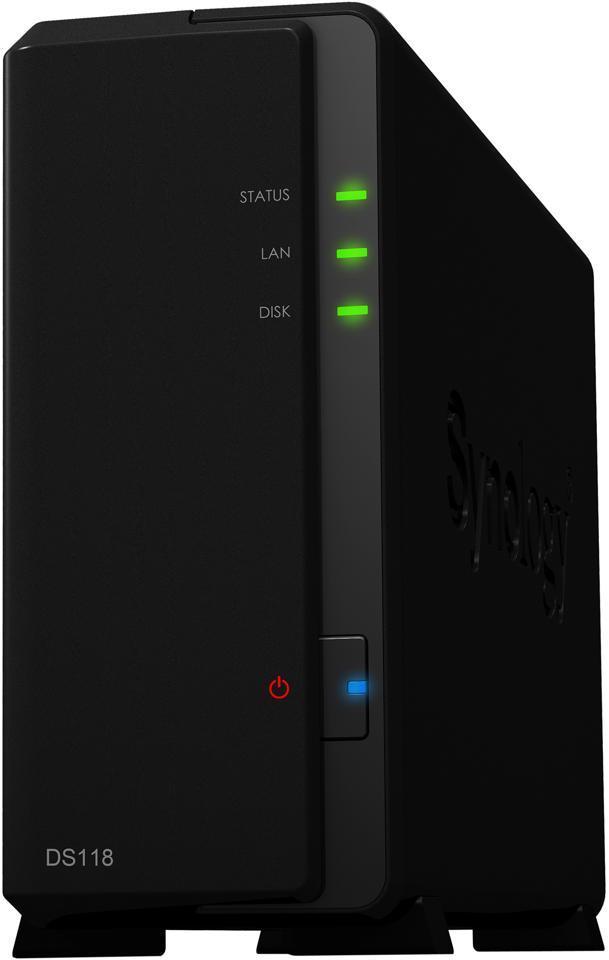
The major negative is that, like most NAS products, it requires an internal SATA drive, which isn’t supplied, so you’re gonna have to bust out your screwdrivers. I recommend just getting a cheap 128 GB internal SATA SSD and then connecting an external SSD (or hard drive, if you need more capacity) to the unit’s USB 3.0 port to use as a backup target. I strongly prefer having the option of being able to directly connect the backup drive to a Mac when restoring, but if you’re content with network-only restoring, you could instead just get a larger internal drive (or drives, if you elect for a multi-bay model).
While it’s not difficult to set up a Synology NAS, configuration is more involved than with some of the other products discussed. You will want to ensure, using its Web interface, that your shared folder (e.g., the root of your external drive) is configured to advertise SMB Time Machine connections over Bonjour/mDNS, and that the drive is formatted for Ext4 (or Btrfs, if you know what that is and are comfortable choosing it, and if Btrfs is supported by the Synology model you own; the DS218 and DS220+ are the minimum options). Note that Synology products won’t even recognize a drive as being eligible for reformatting if it’s not already in one of its natively recognized formats, which can be an issue with external drives that come preformatted for ExFAT. To resolve this, use Disk Utility on your Mac to format the drive as FAT32 (and, as long as you’re bothering, give it a GUID Partition Map scheme), then reformat as Ext4 in the Synology interface. Avoid the temptation to use HFS+ as a file system; like all Linux-based products, the Synology operating system does not support the more reliable journaled variant.
If you choose to attach your Ext4 formatted backup drive directly to your Mac when restoring, you will need Paragon’s ExtFS software to read its contents, but please see the warnings below before doing so. If your drive is instead formatted as Btrfs, there is no way to read it on your Mac apart from a Linux virtual machine.
Western Digital My Cloud Home
Western Digital’s My Cloud Home gives me almost none of what I want, as you can see from the chart above, but it’s essential to include because there is no easier network Time Machine drive to set up (including the Time Capsule). You literally just plug a My Cloud Home into an empty Ethernet port on your router, and it’s ready to use, without any software, registration, or configuration (you can actually ignore all of the setup steps). Just set your Macs to use the My Cloud Home as a Time Machine destination, signing in as Guest when prompted for authentication. That’s it.
The triviality of setup makes the My Cloud Home easy to recommend to my clients who need a plug-and-play remote installation and who don’t require an SSD. The My Cloud Home Duo is a dual-drive version that provides redundancy; your backups are written to two drives, rather than one, so if one drive fails, you don’t lose your backup history. Because no password is required to access the drive itself, I recommend that you encrypt your Time Machine backup when you initially set it up on your Mac.
A word of warning: if you have any intention of using this product as a network file server, consider instead a Synology NAS, such as the model discussed above, or any other traditional NAS device, such as Western Digital’s My Cloud EX2. The very simplicity that makes the My Cloud Home an appealing Time Capsule replacement also makes it an inferior NAS device, lacking even the most basic features you would expect from a typical NAS product. The My Cloud Home is not designed to be an ordinary local network file server, but rather a “consumer cloud” device, so all user and even much file management must be performed via the sluggish and limited WD Discovery desktop software or My Cloud Home mobile app; no internal Web interface is provided. Access to private folders for individual users isn’t available in the absence of the software, and Mac users cannot set up additional shared public folders beyond the “TimeMachineBackups” folder provided by default. Consider the My Cloud Home to be a Time Capsule replacement, nothing more.
Mac Configured for Network Time Machine
Using an entire Mac for network backup is not the most elegant solution and feels like overkill, but it is the only actively developed network Time Machine product made and supported by Apple, and it provides all of what I want. It’s clunky and expensive, given the $700 cost of Apple’s cheapest M1-based Mac mini, so I’m not as enthused as I might be. However, it may cost you nothing at all, if you have an older Mac you wish to dedicate to the task, or if you use a desktop Mac that you can leave on 24/7 and that’s connected by Ethernet to your router. If not, you may also reduce the cost by buying a used Mac.
Although network Time Machine capability, as demonstrated by this Apple support page, is available from macOS 10.13 High Sierra onward, I advise that you run the latest version of macOS available for your Mac to benefit from the most recent security and bug fixes. All Mac models from late 2009 onward are eligible (with the exception of the late 2010 MacBook Air, which lacks any means of connecting Gigabit Ethernet). If you opt for a Mac laptop or iMac that has USB-C ports but no Ethernet port, you will need a USB-C to Gigabit Ethernet adapter, such as this Anker model ($25). For older Mac laptops with neither Ethernet nor USB-C ports, you can purchase an Apple Thunderbolt to Gigabit Ethernet Adapter ($29). If your router is in a tight space, you might wish to consider a used 11-inch MacBook Air or a Mac mini set up to operate without a screen, keyboard, and mouse. For either, utilizing macOS’s screen sharing capability should ease ongoing maintenance. If the Mac you have chosen for network Time Machine also requires backup, its own Time Machine should target a separate volume on the drive being shared, or a different drive entirely.
When using a Mac as a network Time Machine device, I recommend backing up to an external SSD (or hard drive, if high capacities are required), rather than the drive inside the Mac, for maximum flexibility, but that’s a judgment call on your part. One advantage to this setup is that you have many choices for restoring, such as Migration Assistant, Target Disk Mode (or disk sharing on an Apple silicon Mac), and backup software such as Carbon Copy Cloner.
How Would You Restore from a Network Time Machine Backup?
Backup is actually less than half of the equation—restoration is much more important. It doesn’t matter how good your backup is if you can’t restore quickly and reliably. That’s especially true if you need to restore an entire drive. So what is the best way to get to your Time Machine data? There are a variety of issues associated with both hardware and software.
Disconnect from NAS, Connect to Mac
Apple always intended the Time Capsule to operate exclusively over a network connection—its internal drive is not designed to be removable, and its contents are not accessible via USB or Thunderbolt. As such, it was great for backing up laptops but terrible for restoring—depending upon how much data you had, you could wait all day and all night, especially over Wi-Fi. Sometimes you could wait many minutes while looking for a single lost file, hoping that earlier dates would eventually make themselves available.
Some of the NAS products are a bit better in that regard, particularly if you put an SSD inside them. But, when restoring data, direct attachment to a Mac will always yield the quickest operation, even for a hard drive. For this reason, I focused on network backup to external drives, which can be quickly detached and plugged into a Mac, if restoring via the network is not working well.
Attaching a network Time Machine drive directly to a Mac does work, but it has always been unsupported, and it has its quirks, as detailed below. The volume contains a sparse bundle disk image, which itself contains an APFS-formatted volume with nothing but backup snapshots, assuming the backup was started while using macOS 11 Big Sur or later. Time Machine disk images created with macOS 10.15 Catalina or earlier remain formatted as HFS+J, even when used with newer versions of macOS; these utilize directory hard links instead of file system snapshots, so some of the comments below may not apply. You must mount the disk image prior to restoration.
Mac Compatibility of the Underlying File System
The underlying file system of the network Time Machine volume adds to the complexity. If you are using a Mac or an AirPort Extreme for your network backups, great—the backup disk image sits on an APFS or HFS+J volume that your Mac natively understands (which is one reason I like these solutions). When you mount the disk image, you can easily browse the backup snapshots in the Finder, or you can use the Time Machine interface by holding down the Option key and choosing Browse Other Backup Disks from the Time Machine menu.
However, mounting the backup disk is a challenge if your backup drive came from a third-party NAS, router, or Linux computer like a Raspberry Pi. While it’s possible to use an HFS+ formatted volume on these products, I don’t recommend it because the lack of journaling capabilities increases the risk of corruption of backup data.
So, what to do? I was hoping that Microsoft’s NTFS as the file format for the Time Machine volume might provide a happy middle ground, as macOS will natively recognize and mount it read-only (in my view, that’s a plus in a data recovery situation). Unfortunately, I discovered that standard Linux NTFS capabilities are very slow and less than fully featured, omitting some of the journaling capabilities that would make this file system a dependable choice. I was excited to learn that the latest version of the Linux kernel (version 5.15) has all-new NTFS capabilities contributed by Paragon, authors of commercial file system translator software, and indeed I found their new NTFS3 Linux kernel module to perform well on a Raspberry Pi. Unfortunately, it’s not clear that the developers have integrated all of the NTFS journaling features yet, and, worse, I experienced an NTFS-formatted volume that would no longer mount after a sudden power disconnect. I’m hopeful that NTFS might yet become a way forward in the future, but, for the time being, my experience led me to shelve this idea in favor of the tried-and-true Ext4 file system developed for Linux.
Access Linux Ext4 from a Mac, Carefully
Fortunately, Paragon makes a $39.95 Mac utility called ExtFS, which lets macOS mount a volume formatted with Linux Ext4 or Ext3, as you would likely find when directly connecting a drive that came from a third-party NAS to a Mac. I sought to avoid relying on this software because it’s a system extension, meaning permissions must be granted, your Mac must be restarted, you can’t use it while in Recovery mode, Apple could disable it in the future, etc. But it works… sort of. Alarmingly, ExtFS reliably corrupts the sparse bundle disk image if you attempt to open it, making ExtFS a dangerous bit of software to use in a data recovery situation. (I have reported this bug to Paragon, and the company has added the bug to its database.)
So, before attempting to mount the disk image, you must designate the drive as read-only. This is easily accomplished using Paragon’s software; once done, you just unmount and remount the drive, which will then be shown as read-only. At this point, you may safely open the disk image. If you follow this sequence, you will be able to recover individual files or an entire drive, but the razor’s edge you are walking on to get there might advocate for a second, third, or fourth backup destination, whether via Time Machine or another backup solution. If you have the free space, you might also want to first copy the disk image to an APFS or HFS+J volume and mount it from there.
Read-Only Issues
Another quirk of Apple’s new APFS-based Time Machine is that if you mount the backup disk image read-only, as you must when using Paragon’s ExtFS software, you can’t see the backup snapshots in either the Finder or the Time Machine restoration interface. To work around this, you can use software like Carbon Copy Cloner, which can see those snapshots.
An alternative solution is to mount the disk image from the command line in Terminal using a shadow file stored on a writable volume, which will make the disk image faux read-write (changes go into the shadow file, not the actual disk image). When mounted this way, backup snapshots appear as usual in the Finder. The syntax is:
hdiutil attach -shadow /tmp/tmvolume.shadow /Volumes/[Disk Volume Name]/[Backup Disk Image Name].sparsebundle
I strongly recommend making sure you can restore individual files and even entire drives in a controlled test situation before you find yourself in urgent need.
Full Drive Restore via Migration Assistant
Should you wish to restore a Mac’s entire drive, it’s no longer possible, as of Big Sur, to perform a Time Machine full-disk restoration from Recovery mode. Migration Assistant is your only option. You must first reinstall macOS to an empty volume, and then, during initial setup, choose Not Now for data transfer (and in general skip past everything you can, including Apple ID sign-in) to create a user and then install Paragon’s ExtFS if necessary. You may then mount the backup disk image from the Finder (or command line) prior to running Migration Assistant.
If you are using ExtFS, remember to designate the volume containing the disk image as read-only, as described above, before mounting the image. It is not necessary to mount the image read-write via a shadow file for Migration Assistant to be able to transfer from it, even though the backup snapshots are not otherwise visible. You can just double-click the image file in the Finder and then run Migration Assistant after it mounts.
Accessing Older Backups when a Drive Is Directly Connected
When you directly attach a network Time Machine drive, Migration Assistant will see only the most recent backup; it won’t present any backup history. If that’s what you need, no problem. But if you want to restore an older backup, you have a few workarounds at your disposal.
- You can mount the disk image with a shadow file, as described above, and then (non-destructively, because of the shadow file) delete recent backups using the Finder until the backup you want becomes the most recent entry.
- You can copy the disk image to an APFS or HFS+J volume, provided you have the space; double-click the copy to mount it, and use Finder to delete newer backups blocking access to the one you want.
Let’s Back It Up
This odyssey was not as singularly satisfying as I was hoping it would be, but it has been illuminating. My requirements were never what Apple had in mind, even in the era of the Time Capsule. But, with the Time Capsule no longer sold and barely supported, I was free to think about what might work best for network Time Machine backups.
In the end, I’m unsurprised that there is no single right choice, and, due to currently available products using foreign file systems, there probably never will be, at least from my point of view. But I hope what I’ve learned will help you decide how best to back up your Macs over your network. If you have anything to contribute from your own experiences and experiments, please post them in the comments!


